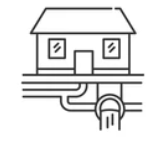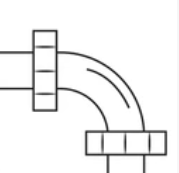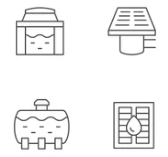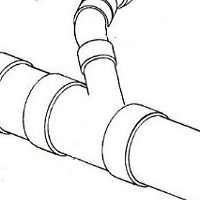Standards
The commonly used standard for CCTV reporting is detailed in the Manual of Sewer Condition Classification Manuals (MSCC). There is difference between drains and sewers, but MSCC allows for this by using a revised subset for domestic
and light commercial drains.
These manuals are produced by the Water Research centre, who also produce a manual called the Drainage Repair Book (DRB). This not only describes repair philosophy but also discusses when a drain might require repair based on its
serviceability.
Viewline works to both these standards, often using automation, meaning that drainage contractors are guided to standard compliant reports and end users receive reports that should also be standard compliant.

Reason for Survey
A CCTV survey is the most commonly used method of establishing the condition of a below ground drain. This maybe to establish the reason behind some known existing problem that is causing a blockage or other issue. Surveys are also
used to establish the condition of the drain at a moment in time. A good example might be for house buying purposes, where the buyer would like to establish the condition of the system prior to purchase.
A CCTV survey is one method of establishing condition or serviceability. Serviceability is a term used to describe the functionality of a drainage system. In terms of DRB grading, a serviceable drain is functional and Grade A. An
unserviceable drain is not functional (normally in terms of potential for blockage) and is termed a Grade C drain. This will require some form of remedial repair work. There may be a question where the drain falls into the grey area
between the two. This type of drain is Grade B.

Other forms of Survey
Although a CCTV survey is the most commonly used method of establishing the condition of a below ground drain it is not the only method. Dependant on the initial investigation purpose or the results of a CCTV survey other forms of
survey, inspection or testing might be required.
If the drainage installation is new (or recently repaired) Local Authority Building Control will require the results of an air test. This is where the new drain is pressurised and monitored. An excessive drop in pressure would result
in a failure.
A water test is very similar, but in this case designed for older drains that are unlikely to pass an air test. In this scenario the system is filled with water at low pressure and left for a specified period of time. Water loss
is then measured to determine a pass or a fail.
In both cases the watertight integrity of the drain is being tested. Water tightness is an important aspect of a below ground drainage system. As well as signifying issues on rigid pipes, such as cracks and fractures, which
might lead to blockages, lack of water tightness may be due to poor joints. Joint issues can be significant as they might not be readily visible but will lead to exfiltration and subsequent erosion. This can eventually lead to pipe
movement and more serious issues. For example if the drain is close to a building’s foundations, soil erosion might lead to subsidence.

Below Ground Drainage Pipework
What makes up a drainage system and what should be surveyed? Obviously there is the below ground pipework that transports waste normally using gravity (there are pumped and vacuum systems) within the network. On private, residential
properties this would be to connect appliances and generally transport waste to the the public sewer, which then takes the waste to a sewage treatment plant. (Where connection to the public sewer is not possible then treatment will
be on site using septic tanks, cess pits and the like).The pipework, in domestic/residential systems, is normally comprised of vitrified clay or polyvinyl chloride (PVC), amongst many other materials, generally with internal diameters
of 100mm and 150mm.
Due to the restricted access nature of drainage pipes, small diameter cameras are designed to survey these
types of below ground pipework systems and reporting applications such as Viewline are then used to convey the survey results in an easy to understand format.

Above Ground Drainage Pipework
This should not be confused with below ground pipework, and is the normally the grey, white PVC pipework that is located above ground and connects sanitary appliances to the below ground system via a down pipe or a soil vent pipe. This is generally not part of a camera survey for various reasons including diameter, access difficulties and design. Normally it is easier to establish an issue with above ground systems.
Down pipes and soil vent pipes are vertical sections of pipe that transport waste from the above ground sanitary pipe network to the below ground sanitary pipe network. A down pipe will take waste from surface water guttering, which takes ace water run off form roof areas. A soil vent pipe takes waste from the foul and grey water network and discharges to the below ground network. Down pipes and soil vent pipes, because they are open to atmosphere at the top, also serve an additional function of enabling good flow conditions to the system.

Drainage Appliances and Equipment
This category applies to the apparatus that enable flow and access to the drainage system. In effect all the drainage appliances other than the pipework itself. This is a fairly large topic, so we will cover the most commonly used
drainage appliances.
The most obvious are items such as manholes, inspection chambers and rodding eyes. These are placed in suitable areas to enable access to the system for maintenance purposes and have covers that can be removed for this purpose.
Other common appliances include gullies, which allow the outfall of surface or grey water via a grilled, surface level water trap. These are commonly found at the base of surface water down pipes. Another common method of surface
water dispersal is by use of a channel drain. These channels are normally covered by a grill and outfall to the below ground system by a water trap (similar to a gulley).
Victorian properties may have a different type of trap on the main outfall drain that is designed to prevent smell coming back from the public sewer (in fact every water trap on any appliance is designed to stop smells). These are
called Buchan or Winser traps, although in some areas they are called interceptors.

Drain and Sewer Definitions
A drain is a pipe that serves the purpose of draining water and waste from a building and any other associated structures like a garage.
A lateral drain, on the other hand, is a pipe that carries wastewater from your property to a sewer. It is usually located outside the boundaries of your property, often beneath a public pavement or road. In some cases, a lateral drain may run beneath your property if you share a sewer with your neighbour.
A sewer is a network of pipes that collects water and waste from multiple drains and various buildings. Most sewers are operated and maintained by water companies. Some properties are not connected to a sewer but rely on alternative systems like a cesspool, septic tank, or treatment plant for wastewater disposal. In such cases, the property owners are not required to pay sewerage charges to a sewerage company. The pipe work connections in these cases would be defined as drains.

Single Property Maintenance Responsibility
The property owner is responsible for maintaining and repairing any drains that are inside the boundaries (curtilage) of the property. These are known as private drains. If there are any issues with private drains, the property owner
needs to arrange and pay for the repairs. Be aware that if any other property is connected, prior to or within the property boundary, then at this point this becomes a Lateral Drain. The property owner is not responsible for
maintaining or repairing lateral drains; instead, the local water company is responsible for them. Owners have the freedom to choose whichever company they prefer to do the work. It’s also possible to take out insurance that covers
the cost of work on private drains. Some building insurance policies may already include coverage for private drains, so it’s essential to check with your insurance provider.
There are situations where local authorities or environmental health departments may intervene:
– If your private drain is deemed inadequate or causing blockages, the local authority may order you to carry out improvement work or replace the drain.
– In some cases, the local authority can undertake the necessary drain work themselves and then charge you for the cost.
It’s crucial to understand your responsibilities regarding drain maintenance and repairs to ensure the proper functioning of your drainage system and compliance with local regulations.

Multiple Property Maintenance Responsibility
In England, the responsibility for maintaining the drainage system of a block of flats can vary depending on the specific arrangements outlined in the lease or ownership documentation. Typically, there are two common scenarios:
1. Freehold Ownership: If the entire block of flats is owned by a single entity or individual (freeholder), then the freeholder is usually responsible for maintaining the drainage system and other common areas of the building.
2. Leasehold Ownership: In many cases, flats in England are sold on a leasehold basis. This means that individual units are owned by leaseholders, and there is a freeholder or management company responsible for maintaining the common areas, which can include the drainage system.
In the case of a site such as a university campus or school, maintenance responsibility remains with the property or estate owner as far as the curtilage of the estate. At this point the local water authority is responsible for maintenance.



